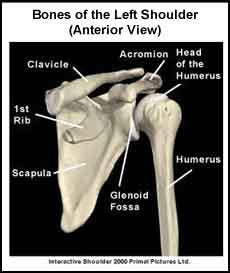This section is a review of basic shoulder biomechanics. In order to better understand the biomechanics of the shoulder it is important to understand its anatomy. Please read the section on basic shoulder anatomy before reading this section. It discusses bones, ligaments, muscles and other structures that make up the shoulder joint.
Recommended book for learning about human biomechanics:
A recommended book for learning more about human biomechanics is Basic Biomechanics of the Musculoskeletal System.

What joints make up the shoulder complex?
There are three joints in the shoulder complex. The main joint is the glenohumeral joint. It is a ball and socket (modified ovoid) joint and it is the most mobile joint in the body. The top of the humerus is shaped like a ball and it sits in a socket on the end of the scapula. The ball is called the head of the humerus and the socket is called the glenoid fossa, hence the term “glenohumeral” joint.
The other two joints in the shoulder complex are the sternoclavicular joint and the acromioclavicular joint. The sternoclavicular joint connects the inner (medial) part of the collarbone (clavicle) to the breastbone (sternum). The acromioclavicular joint connects the outer (lateral) part of the clavicle to a projection at the top of the shoulder blade (scapula) called the acromion process. The scapula sits on the ribs and moves as the arm moves.
The movements of the glenohumeral joint include forward lifting of the arm (flexion), backward lifting of the arm (extension), inward (internal) rotation, outward (external) rotation, movement of the arm away from the body (abduction) and movement of the arm towards the body (adduction).
What is scapulo-humeral rhythm?
The coordinated movement of these joints during arm movement is referred to as the scapulo-humeral rhythm. Movement at the glenohumeral joint requires motion at the other joints of the shoulder complex. The scapulo-humeral rhythm describes movement that occurs at the glenohumeral joint compared to movement that occurs at the other shoulder complex joints, the sternoclavicular, the acromioclavicular and the scapulothoracic joints. The scapulothoracic joint is not a true joint but it describes movement of the scapula against the thoracic wall during arm movement.
The scapulo-humeral rhythm allows the shoulder to move through its full range of movement and it allows the head of the humerus to be centered within the glenoid fossa. For every 15 degrees of shoulder abduction, 10 degrees occurs at the glenohumeral joint and 5 degrees occurs at the scapulothoracic joint. For 180 degrees of shoulder abduction, 120 degrees occurs at the glenohumeral joint and 60 degrees occurs at the scapulothoracic joint. If there are changes to the scapulo-humeral rhythm, the head of the humerus does not remain centered and it can lead to problems with the rotator cuff tendons such as tendonitis or rotator cuff impingement.
The muscles of the shoulder complex provide stability and movement. During shoulder movements such as lifting, certain muscle groups help to move the shoulder, while other muscle groups help to stabilize the shoulder complex. Much of the stability in the shoulder complex is provided by this muscular coordination.
Poor posture, muscle weakness or ligament injury can lead to abnormal biomechanics of the shoulder, which can result in abnormal forces in the shoulder. Over time these abnormal forces can cause injury to the soft tissues or the articular cartilage of the glenohumeral joint.
